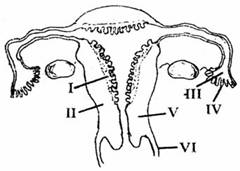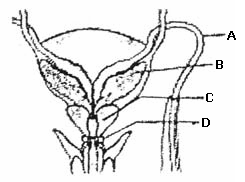NEET Human Reproduction Questions | Chapter wise MCQ Test on NEET Human Production | Test no. 04
Human Reproduction MCQs Quiz - 04
Congratulations - you have completed Human Reproduction MCQs Quiz - 04.
You scored %%SCORE%% out of %%TOTAL%%.
Your performance has been rated as %%RATING%%
Your answers are highlighted below.
Question 1 |
Human seminal plasma, the fluid part of semen, is produced by contributions from the:
i. Urethra
ii. Prostate
iii. Seminal vesicle
iv. Bulbourethral gland
i and iii | |
i and iv | |
i, iii and iv | |
ii, iii and iv |
Question 2 |
Which one of the following statement is correct?
Spermatogenesis is the formation of sperm cells. | |
Spermatogenesis occurs in the seminiferous tubules. | |
Follicle-stimulating hormone (FSh) indirectly stimulates spermatogenesis. | |
All of these are correct |
Question 3 |
Which one of the following statements is incorrect about menopause?
Generally occurs between the ages of 45 and 55 | |
Causes the cessation of the female reproductive cycle | |
Anterior pituitary no longer produces FSH and LH | |
Ovaries slowly reduce their secretion of estrogen |
Question 4 |
Which one of the following statement is correct about sertoli cells also called as nurse cells?
Found in adrenal cortex and secrete adrenaline | |
Found in ovaries and secrete progesterone | |
Found in pancreas and secrete cholecystokinin | |
Found in Seminiferous tubules and provide nutrition of germ cells |
Question 5 |
Which one of the following statements about morula in humans is correct?
It has more cytoplasm and more DNA than an uncleaved zygote | |
It has almost equal quantity of cytoplasm as an uncleaved zygote but much more DNA | |
It has far less cytoplasm as well as less DNA than in an uncleaved zygote | |
It has more or less equal quantity of cytoplasm and DNA as in uncleaved zygote |
Question 6 |
Foetal ejection reflex in human female is induced by
Differentiation of mammary glands | |
Pressure exerted by amniotic fluid | |
Release of oxytocin from pituitary | |
Fully developed foetus and placenta |
Question 7 |
Which one of the following is the most likely root cause why menstruation is not taking place in regularly cycling human female?
Retention of well-developed corpus luteum | |
Fertilisation of the ovum | |
Maintenance of the hypertrophical endometrial lining | |
Maintenance of high concentration of sex-hormones in the blood stream |
Question 8 |
The correct sequence of spermatogenetic stages leading to the formation of sperms in a mature human testis is
Spermatogonia-spermatid-spermatocyte-sperms | |
Spermatocyte-spermatogonia-spermatid-sperms | |
Spermatogonia-spermatocyte-spermatid-sperms | |
Spermatid-spermatocyte-spermatogonia-sperms |
Question 9 |
Correct sequence of embryo development:
Gamete → Zygote → Morula → Blastula → Gastrula | |
Gamete → Zygote → Blastula → Morula → Gastrula | |
Gamete → Neurula → Gastrula | |
Gamete → Neurula → Morula |
Question 10 |
Which one of the following statements is incorrect about menstruation?
The beginning of the cycle of menstruation is called menarche | |
During normal menstruation about 40 ml blood is lost | |
The menstrual fluid can easily clot | |
At menopause in the female, there is especially abrupt increase in gonadotropic hormones |
Question 11 |
The hemoglobin of a human foetus:
Has a higher affinity for oxygen than that of an adult | |
Has a lower affinity for oxygen than that of the adult | |
Its affinity for oxygen is the same as that of an adult | |
Has only two protein subunits instead of four |
Question 12 |
What happens during fertilisation in humans after many sperms reach close to the ovum?
Cells of corona radiata trap all the sperms except one | |
Only two sperms nearest the ovum penetrate zona pellucida | |
Secretions of acrosome helps one sperm enter cytoplasm of ovum through zona pellucida | |
All sperms except the one nearest to the ovum lose their tails |
Question 13 |
Column I contains terms and column II contains definitions. Match them correctly and choose the right answer.
| Column I | Column II | ||
| A | Parturition | p | Attachment of zygote to endometrium |
| B | Gestation | q | Release of egg from Graafian follicle |
| C | Ovulation | r | Delivery of baby from uterus |
| D | Implantation | s | Duration between pregnancy and birth |
| E | Conception | t | Formation of zygote by fusion of the egg and sperm |
| u | Stoppage of ovulation and menstruation |
A = q, B = s, C = p, D = t, E = r | |
A = s, B = r, C = p, D = t, E = q | |
A = t, B = p, C = q, D = r, E = s | |
A = r, B = s, C = q, D = p, E = t |
Question 14 |
The figure given below depicts a diagrammatic sectional view of the female reproductive system of humans.
Which one set of three parts out of I – VI have been correctly identified?


(I) Perimetrium, (II) Myometrium, (III) Fallopian tube | |
(II) Endometrium, (III) Infundibulum, (IV) Fimbriae | |
(III) Infundibulum, (IV) Fimbriae, (V) Cervix | |
(IV) Oviducal funnel, (V) Uterus, (VI) Cervix |
Question 15 |
Given below is a diagrammatic sketch of a portion of human male reproductive system. Select the correct set of the names of the parts labelled A, B, C, D.


| A | B | C | D | |
| (1) | Ureter | Seminal vesicle | Prostate | Bulbourethral gland |
| (2) | Ureter | Prostate | Seminal vesicle | Bulbourethral gland |
| (3) | Vas deferens | Seminal vesicle | Prostate | Bulbourethral gland |
| (4) | Vas deferens | Seminal vesicle | Bulbourethral gland | Prostate |
Option (1) | |
Option (2) | |
Option (3) | |
Option (4) |
Once you are finished, click the button below. Any items you have not completed will be marked incorrect.
There are 15 questions to complete.
Tags: NEET Biology MCQs | NEET Biology Practice Questions | NEET Biology Previous Questions | NEET Biology Questions Chapter wise



really nice question
the answer of que. no. 7 should be option B.
is ques 7 single option correct?? a & b may also be the reason…. plz reply
yewah.. i totally agree wd u…the answer should be second..as pregnancy ceases menstrual cycle….
no… actually that is the technical fact tht if there is no fertilization n pregnancy a female will have periods.. but they are asking the basic reason for non occurence of REGULAR MENSTRUAL CYCLE
i too agree wid u .it should be b only, tht’s the simple logic.
The main reason for stopping menstrual cycle is production of progesterone ,which maintenance the endometrium .So that is the main reason . What u said r also correct but they happen due to increase in progesterone
very good ques.
thanx for this opportunity